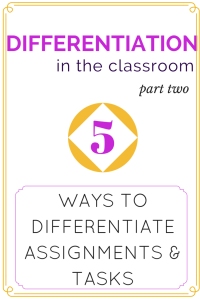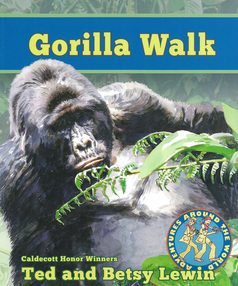Differentiated, or tiered, assignments provide students opportunities for individual understanding and growth in learning. Activities, projects, and tasks that educators create for their students can be used with flexible groups to address common learning needs.
Based on students’ diverse needs, educators differentiate by manipulating one or more of the following: content (what students learn), process (how students learn it), and product (what students create to demonstrate their learning).
Within those three domains, educators can differentiate based on challenge, complexity, resources, process, and product. We will tackle 5 ways to differentiate assignments using the Adventures Around the World series by Ted and Betsy Lewin.
Differentiate by Challenge Level:
We use Bloom’s Taxonomy as a guide to develop instructional tasks with differing degrees of challenging demands. Based on the rigor and complexity of what is being taught, we can design and categorize assignments using the following classifications from Bloom’s levels of higher thinking: recall, understand, apply, analyze, evaluate, and create.
Example: Top to Bottom: Down Under
Recall: List the different types of wildlife that live in northern and southern Australia, and classify them as mammals, reptiles, birds, amphibians, or fish.
Understand: Identify and explain the adaptations of the platypus or echidna in their habitats.
Create: Design a new Australian animal incorporating the characteristics of two animal classifications (mammal, reptile, amphibian, bird, fish) and a written explanation supporting your reasons.
Differentiate by Complexity:
Increasing the complexity of an assigned task involves differentiating the content, or an introductory vs a more advanced activity focus. This involves strategically developing learning objectives and understanding what students should be able to do. Again, Bloom’s Taxonomy can help guide the development of least, more, and most complex tasks for your students.
In the following example, all of the students are required to write an informational essay, but the lens of their research differs in complexity.
Example: Horse Song: The Naadam of Mongolia
Least complex: Write an informational essay about the tradition of the Naadam horse racing in Mongolia.
More complex: Write an informational essay about the tradition of the Naadam horse racing in Mongolia and evaluate the pros and cons.
Most complex: Write an informational essay about the tradition of the Naadam horse racing in Mongolia and determine your opinion, presenting a convincing argument either for or against the horse races.
Differentiate by Resource:
Differentiating by resource should be approached with thoughtful consideration of students. This requires thinking about their reading strengths and needs, as well as students’ interest in and prior knowledge about a topic. Differentiating by resource may involve selecting supplementary reading materials, such as articles, magazines, and primary documents, and using visual aids, including videos, charts, and graphic organizers. Offering all students opportunities to engage with different resources and assigning age-appropriate materials to groups of students supports collaboration and inclusion of readers of all levels.
Example: Gorilla Walk
Lower-level readers: Provide supplementary informational texts or materials about the endangered mountain gorilla on a lower reading level, such as a pre-reading guide/outline for Gorilla Walk, an audio recording of Gorilla Walk to listen to as students read along, or a graphic organizer to record notes as students read.
Advanced readers: Provide challenging supplementary articles or texts about the endangered mountain gorilla or animal habituation and critical-thinking questions to answer as students read the text.
Differentiate by Process:
When students are expected to achieve similar outcomes, such as understanding new vocabulary words, teachers often differentiate assignments by how students will achieve expected learning objectives. Therefore, how students engage with the content involves considering how challenging and complex the process or strategy is for the student, as well as offering varying and supplementary resources.
Example: Elephant Quest
Vocabulary words: delta, protrude, submerge, matriarch, bounding, intent, emerge
- Frayer Model: Students will use the Frayer model to: define the word in their own words, list essential characteristics of the word/concept, and provide both examples and nonexamples.
- LINCS strategy: (on an index card)
L: List the word + definition
I: Identify a reminding word
N: Note a LINCing story
C: Create a LINCing picture
S: Self-test
- Morphemic(structural) analysis: Analyze each vocabulary word by their morphemes (smallest meaningful units): prefixes, base word, root words, and suffixes.
Differentiate by Product:
When students are all provided with the same materials, educators may decide to differentiate the assignment by outcom e, or what students are expected to be able to do in order to demonstrate gained knowledge. Differentation by product is valuable in encouraging student success and practice in other areas of thinking and learning.
e, or what students are expected to be able to do in order to demonstrate gained knowledge. Differentation by product is valuable in encouraging student success and practice in other areas of thinking and learning.
Example: Puffling Patrol
Visual/Spatial: Create an informational video advertisement persuading people to join the Puffling Patrol on the island of Heimaey.
Verbal/Linguistic: Create an informational brochure persuading people to join the Puffling Patrol on the island of Heimaey.
For further reading on differentiation:
- 5 Harmful Differentiation Myths: Part 1
- Heacox, D. (2012). Differentiating instruction in the regular classroom: How to reach and teach all learners. Minneapolis, MN: Free Spirit Publishing, Inc.
 Veronica has a degree from Mount Saint Mary College and joined LEE & LOW in the fall of 2014. She has a background in education and holds a New York State childhood education (1-6) and students with disabilities (1-6) certification. When she’s not wandering around New York City, you can find her hiking with her dog Milo in her hometown in the Hudson Valley, NY.
Veronica has a degree from Mount Saint Mary College and joined LEE & LOW in the fall of 2014. She has a background in education and holds a New York State childhood education (1-6) and students with disabilities (1-6) certification. When she’s not wandering around New York City, you can find her hiking with her dog Milo in her hometown in the Hudson Valley, NY.

